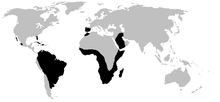
Back سحالي دودية وأشباهها Arabic سحالى دوديه واشباهها ARZ Amfisbenlər Azerbaijani Амфізбены Byelorussian Амфізбэны BE-X-OLD Двуходки Bulgarian Amfisbenis Catalan Amphisbaenia CEB Dvouplazi Czech Ormeøgler Danish
| Amphisbaenians Temporal range: Late Cretaceous – Present
| |
|---|---|

| |
| Blanus cinereus, Spain | |
| Scientific classification | |
| Domain: | Eukaryota |
| Kingdom: | Animalia |
| Phylum: | Chordata |
| Class: | Reptilia |
| Order: | Squamata |
| Superfamily: | Lacertoidea |
| Clade: | Amphisbaenia Gray, 1844 |
| Families | |
|
Amphisbaenidae | |

| |
| Black: range of Amphisbaenia | |
Amphisbaenia /æmfɪsˈbiːniə/ (called amphisbaenians or worm lizards) is a group of typically legless lizards,[1] comprising over 200 extant species. Amphisbaenians are characterized by their long bodies, the reduction or loss of the limbs, and rudimentary eyes. As many species have a pink body and scales arranged in rings, they have a superficial resemblance to earthworms. While the genus Bipes retains forelimbs, all other genera are limbless. Phylogenetic studies suggest that they are nested within Lacertoidea, closely related to the lizard family Lacertidae.[1] Amphisbaenians are widely distributed, occurring in North America, Europe, Africa, South America, Western Asia and the Caribbean. Most species are less than 6 inches (15 cm) long.
- ^ a b Tałanda, Mateusz (January 2016). "Cretaceous roots of the amphisbaenian lizards". Zoologica Scripta. 45 (1): 1–8. doi:10.1111/zsc.12138. ISSN 0300-3256.
© MMXXIII Rich X Search. We shall prevail. All rights reserved. Rich X Search